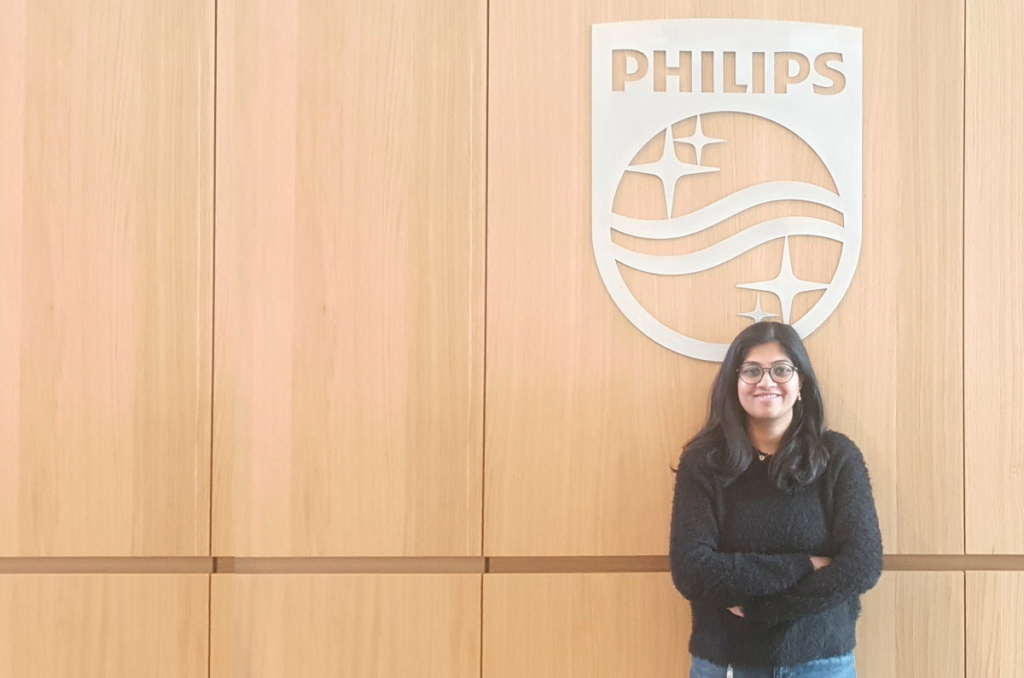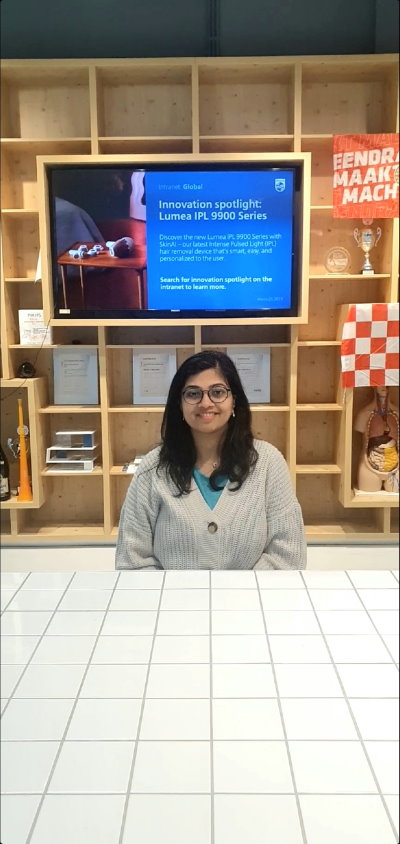
Taste of Philips gives appetite for more
Having worked for five years in the software industry in Bangalore, in her native country India, Priyanka Patel desired a change of scenery. Friends pointed her to the EngD Software Technology (ST) at Eindhoven University of Technology (TUE). “I was ready for a new challenge. I wanted to broaden my software experience. Several friends of mine had done a master’s in the Netherlands and one of them had subsequently joined the ST program, while others were considering it. They were all very positive about the traineeship and after some more orientation, I signed up.”
Patel enrolled as an ST trainee in 2018 and graduated in 2020 at Philips. During the EngD program, she’d gotten such a good vibe from the company that she almost immediately returned to start her professional career there. “I really enjoyed my time as a trainee at Philips. I liked the environment and culture so much that I came back for more.” And despite the reorganization it’s going through now, Philips remains a Dutch multinational shaping an important part of the world’s technological future. “It’s an international company and I’ve always wanted to work in healthcare, where you can truly make a difference.”

Industrial focus
TUE’s EngD ST is a two-year salaried post-master technological designer program for top MSc graduates in computer science or a related field. It prepares them for a career in industry by strengthening their theoretical basis and confronting them with complex system/software challenges from industrial partners. The students learn to develop innovative solutions meeting industry standards while mastering all the aspects of teamwork, different roles and professional skills.
“The program isn’t only about the core computer science subjects; it’s just as much about preparing you as an individual for your future work in industry,” Patel explains. “It’s a pretty intensive two-year track in which you get trained in topics like model-based software engineering, machine learning and the internet of things but also in software architecting, agile project management and the required soft skills. For me, this broad offering, covering the end-to-end software engineering portfolio, is one of the program’s main attractions.”
Patel highly values the industrial focus. “Next to the many lectures and workshops by experts from both academia and industry, the bulk of the traineeship consists of projects in which you apply the learnings at companies in the Brainport region. It starts with three smaller assignments, of 2-3 months each, in which you have different roles. I was a designer for an AI-empowered speech analysis system at Philips, a designer and scrum master for a traffic warning service at the C-Mobile EU project and an architect for a software architecture revision project at ASML. The program is concluded by a 10-month graduation project. I did mine at Philips Research again, taking different roles in developing a unified messaging platform for support requests from hospitals.”
Real customers
“When a hospital has an issue with Philips equipment, they call our customer service. Like any phone-based support, this comes with its own set of problems, including long waiting times, not immediately getting the right person on the line and having to explain the problem over and over again. My assignment was to help digitalize this communication to streamline it without complicating it,” says Patel, detailing her graduation project.
“We developed a platform that encapsulates different messaging capabilities, like audio and video, chat, e-mail, push notifications and SMS. Users choose their preferred mode of communication depending on the situation. For simple requests, there’s chatbot-like functionality. For critical support, the platform can set up a live connection to a human operator,” Patel elaborates. “I was responsible for the chat, mail, push and SMS interfaces to the back-end system. Philips liked my work so much that they put it in an application they were piloting in the North American market. The fact that it was used by real customers made me very proud.”
Patel carried out her graduation project at Philips Research, stationed at the High Tech Campus in Eindhoven. “Being part of a research department was a new experience for me,” she tells, looking back. “I’d mainly worked in engineering teams, where you get most of the requirements and your task is to design and develop them. In research, however, you don’t get the answers handed to you. You have to go and look for them. That was challenging for me in the beginning, but I’ve really come to appreciate it because it gives you a helicopter view of everything that’s going on.”

Well-rounded
Shortly after her graduation in 2020, Patel returned to the warm nest. “It didn’t feel like starting a new job at all. I was assigned to the same team within Philips Research and I more or less continued what I’d been doing as a trainee, but now, we were going from a pilot to adoption on a much larger scale. Having gotten to know the company from the inside during the ST program gave me a solid head start.”
In July, Patel transferred to a new assignment within Research. “My ‘old’ project is still ongoing, working toward market release. I’ve moved on to a team that’s developing generic platforms to connect devices and services in the medical technology space. We’re laying the groundwork for future healthcare applications.”
Thanks to the ST program and the experience gained at Philips, Patel has become much more well-rounded, not only as a software designer and engineer but also as a person. “I’ve worn different hats in a development team. I’ve worked in different environments, with people from different backgrounds. I’ve evolved from a software developer executing tasks with a very narrow focus to being in the driver’s seat, communicating transparently and seeing the bigger picture.”
Main picture credit: Priyanka Patel. This article was written in close collaboration with Eindhoven University of Technology’s EngD Software Technology program.





